- Home
- Diana Wynne Jones
Reflections: On the Magic of Writing Page 6
Reflections: On the Magic of Writing Read online
Page 6
But I came out of a billow of turgid sentences still assuming that writing for adults gave me more freedom, for instance, in the way I could tell the story. I could split my cast of characters up and flip from one to another. I could have a short section on Tod, outcast on Earth and bewildered by it, followed by a longer account of Flan, who is in a pocket universe having a nervous breakdown, and then jump to Zillah accompanying a centaur into an alternative world. Everyone concerned with children’s books assumes that children have trouble with this kind of narrative method and I got gleefully to work. Then I realized that this freedom was equally illusory. Adults may expect this, but it is also the narrative method of Doctor Who, and anyone who can follow Doctor Who can follow this in their sleep.
But there really is greater freedom in writing for adults, you will be saying. What about the actual content of the story? All of sex, violence, politics, and the arcane skulduggery of science or mage craft would be mine to use. Yes, despite the fact that I had used all of these in Power of Three, I did assume I had this freedom. I did. The measure of that freedom can be seen from my saying with increasing uneasiness as I wrote, “This isn’t like any adult speculative fiction I ever read!” My would-be editor echoed this exact phrase, dubiously, and followed it with, “And you seem to be mixing science fiction and fantasy here.” Oh dear. These are simply not problems writing for children. The new and different thing is welcomed. Numerous teachers and librarians refuse shelf space to writers like Enid Blyton, on the grounds that they always write the same book; and as for the mixing of genres—well, there is only the one and that is books for children. For children, if I want to send a decrepit starship full of witches to a quasi-monastery in another adjacent universe, no one turns a hair. But adults are handicapped by terminal assumptions about what goes with which genre. If they think I am writing fantasy, then my belligerent witches must go on a quest armed only with swords and spells and either on foot or horseback; and if what I am doing is to be science fiction, no one aboard my starship is allowed magic, but only scientific principles not altogether yet proven, such as an ability to travel faster than light.
Does nobody find these unspoken assumptions absurd? There is another: sex. Contrary to most popular belief, children’s books concern themselves vastly and outspokenly with sex, for two main reasons: first, because children are so frequently abducted and raped; and second, because children have to spend so much of their lives dealing with the sex life of their parents—particularly when those parents are divorcing. True, scenes of explicit sex between adults are not much use to children—it affects them rather like the drunk across the street affects you when you happen to be cold sober and in a hurry—but most of them can’t wait to grow up and try it. But when such scenes are an essential part of the story, no one makes any bones about putting them in. They run the whole gamut, too, of human emotions, through rapture, tragedy, and comedy, and all the smaller emotions besides. Now when I came to write for adults, I assumed I had the same freedom, and more. And this surface assumption of mine fell foul of another underlying assumption as soon as my would-be editor read the book.
My witches were invading a place full of polite and largely innocent quasi-monks. Apart from the fact that they were all witches, each woman was as different from the others as may be a real person in her own right. So, as usual, I sat down and thought carefully, “Now what would really happen, to this real woman in this situation? And to this and these real men?” The answer is various on both sides: a lot of guilt, a lot of pressure from inside and outside the group of women, and an awful lot of whoopee at some point when enough people relaxed enough. In the course of it two-thirds die, two get badly victimized, one falls into a clinical depression, one gets blackmailed, everyone’s judgment goes askew, and one woman runs away and nearly gets her small child killed. The assumptions I had ignored came out in my would-be editor’s response: “It’s all so nice.” I said, “I beg your pardon?” The reply was, “Well, most writers would take this opportunity to make everything miserable and tragic—and you had one pair fall in love.” I had. It seemed to me that they would, those particular ones. In fact, they did it without any help from me. “Now what’s going on here?” I thought. I am assumed to be writing fantasy. Therefore, it seems, where adults are concerned, one must only write of sex in fantasy in a tragic and elegiac way. People are not supposed to behave in the way that people would. Oh no. Surely this is only one editor’s aberrant assumption? But I fear not.
This kind of thing cuts down the freedom one ought to have when writing for adults to a point which I find claustrophobic. It gets worse when I realize that there were certain sorts of story which I didn’t even consider. To take two examples, I knew I couldn’t write anything like Vivien Alcock’s The Monster Garden or Philippa Pearce’s Tom’s Midnight Garden. The Monster Garden is simply a rewrite of Frankenstein, in which a modern girl called Frankie (!) accidentally grows some protoplasm from her father’s lab into a creature. As in all children’s books, nothing turns out as you’d expect (which is part of the beautiful freedom of this branch of writing), but this plot is unavailable for adults because everyone knows it’s been done before. Adults are supposed to be sophisticated about this. In that case, would someone tell me why people keep writing the one about the female warrior with the map in the front? Or why Frankenstein is a no-no, while everyone is free to reuse The Lord of the Rings? The rationale of these assumptions escapes me.
Tom’s Midnight Garden is a branch of time-travel writing (loosely related to that of Dickens in A Christmas Carol) in which a ghost from the past takes a lonely small boy to explore the house and countryside as it was in his grandmother’s day. It is most elegantly and exactly done and rightly a children’s classic, but what adult would accept a plot like that outside Dickens? This really raises the whole large question of time travel, which I will reserve for a later date, only pointing out here what seems to be the hidden assumption: adults can only accept time travel on a fairly gross scale. Time travel up or down a generation or so is only allowed for breeding purposes (either with one’s mother or one’s niece). Otherwise one has to go back to, say, Roman times or way back to our origins—and then only when provided with plenty of anxious archaeological explanations. Personally, since I like more modest time trips better, I think this is a pity.
In fact, it is all a pity. Every hidden assumption I discovered seems to be felt as a law, or a rule, or an absolute difference between two branches of writing, and I cannot see they are any such thing. They shackle the speculative fiction written for adults and reflect badly on that written for children—since the final hidden assumption has to be that as fiction written for adults is so puerile, how much more so must fiction written for children be? This, I know, is not the case. But let no one argue that these hidden assumptions about writing for adults are not there. I assure you they are. I felt every one of them like a ball and chain when I tried to do it. I think it is high time people started examining them in order to free the wealth of good stories cramped under this load of old iron. For, when all is said and done, it is telling a good story, and telling it well, that is the point of both kinds of writing.
When I Won the Guardian Award
Diana Wynne Jones won the prestigious Guardian Children’s Fiction Prize (then known simply as the Guardian Award) in 1978 for Charmed Life. Since 1967, the Guardian has given an annual award for the best children’s book written by a British or British Commonwealth author and published in the UK during the preceding year. A panel of authors, along with the reviews editor of the Guardian’s children’s books section, judges the award.
When I won the Guardian Award for Charmed Life (in 1978 I think it was), I was exceedingly astonished—and also very, very pleased. The reason for both these feelings was that the judges were all writers themselves. There is nothing more flattering than having your book liked by people who do the same thing as you do—because, surely, they must be the hardest to fool and the hardest
to please. They know how to do it: if they think you’ve done it right, then you have.
It turns out that I was right to feel that way. If I’d known then what I know now, I’d have been even more surprised and flattered, because people who have won this award were always asked to be one of the judges for next year. I have been doing that. As soon as I got home from a book fair in Rochdale, books began to arrive, stacks of them, two nearly every day. It was better than Christmas. The rest of my family began to get rather envious. Until, that is, they saw the books. Then they said things like, “I wouldn’t read that lot if you paid me!” and turned away.
I thought they were being a little unreasonable. After all, as I well knew, it takes a lot of time and a vast amount of effort to write a book. You ought to do people the courtesy of deciding you don’t like a book after you’ve read it at least. So I read diligently—luckily I read fast—three or more books a day. And it did impress me what a lot of time and what a vast amount of effort these writers had put into their books. I felt I couldn’t be so unkind as to dislike any of them. I wrote long, long notes on each book, pointing out to myself all the good things these authors had done.
Well. Armed with this heavy stack of kind remarks, I went to London to meet the other writers on the panel. The judging began.
“Now what about this book?” said the chairperson. “Fairies at the Bottom of the Garden, by Selina Slime?”
And all hell broke loose.
“Disgusting! Horrible! Terrible!” shouted the writers. “Are people still writing such things? No marks!”
“Then how about this beautiful historical romance?” asked the chairperson. “In the Hands of Crusoe’s Cannibals?”
“Dreadful!” yelled the authors. “Nobody gets to eat anybody.”
“Then,” said the chairperson desperately, “how about this lovely description of how it feels to be a child at a bad school—Hero of the Slum, by Sylvester Glum?”
By this time I had realized that my kind notes were just hiding my true feelings, and I began yelling with the rest. “Revolting! Who’s this Glum trying to fool?!”
“Terrible do-gooding book!” bawled all the rest.
“Then what about this charmingly poetic—” began the chairperson.
“NO!” we screamed. “Tear it up!”
In short, we were utterly ruthless, terribly noisy, and quite right. There did finally come a book at which we all screamed “YES!” even louder. And started reading bits out and howling with laughter and interrupting one another to say what the best bits were. And it was a terribly good book.
But when I was on the train, going back home, I did think, “Good heavens! I wonder what they all screamed about my book?”
Reading C. S. Lewis’s Narnia
This commentary on The Chronicles of Narnia was originally delivered at a conference on C. S. Lewis. The article has also been published on www.amazon.com as “The Magic of Narnia.”
Before my student days I knew C. S. Lewis merely as the author of The Screwtape Letters. These were read out at morning assembly in my school, and very whimsical and condescending I found them, feeding you Christianity by pretending to speak as a devil—though I had to admit this was very good as an idea.
Judge my surprise when I went up to Oxford and discovered that this devil’s advocate was a small, pear-shaped man with a mighty, rolling voice and quite formidable learning. His lectures were called “Mediaeval Prolegomena”—a title, you might think, to put anyone off. In fact, he filled the largest lecture hall to overflowing every week, discoursing from memory about the underlying beliefs of the Middle Ages with such vision, humor, and total clarity that his audience became excited enough almost to cheer.
Quite soon after, I had the splendid experience of discovering Lewis’s Narnia books when my own children did. The excitement I remembered from his lectures was there, and the learning, and the clarity. There was also a measure of the whimsy I knew from The Screwtape Letters, but here it pulled its weight, since it was coupled with an outflowing of the imagination which gripped me and my children alike. The books are all surprisingly short. But an immense amount happens in each, apparently leisurely, yet with all the crowding action you are never in doubt what is going on. You can see everything that happens, so that surprisingly young children—one of mine was only two—can understand every incident. This is despite the fact that Lewis mines material from his own huge learning, drawing on theology, Renaissance geography, myth, folktales, medieval writings, and even earlier children’s books, and through this he contrives to talk of the obscurer movements of the human mind in the face of faith. I marveled and learned from it.
The Lion, the Witch and the Wardrobe, Lewis said, started with his vision of a faun walking in the snow beside an old-fashioned streetlight. It begins a little stiffly (and this stiffness never leaves his child protagonists) because he is feeling his way, and does not really take off until the advent of the lion, Aslan, with whom Lewis discovered he could tap in to deeper tragedy and triumph. For me, this was his major discovery: that you can invoke the whole range of human thought and feeling by beginning from one simple, clear scene. But Lewis himself asserted that it was the talking animals that truly fascinated him. He has a field day with these in Prince Caspian.1 By this book he is totally assured, and the pace and scope of the story are breathtaking—myths mingle, alternate worlds clash, and you get a profound sense of the changes history brings.
That was almost my children’s favorite, but the one they put top was The Voyage of the Dawn Treader,2 where Lewis plunders medieval and Renaissance travel tales to give a limpid, episodic account of Caspian’s journey to the ends of eternity. My children’s best-loved episode was where Eustace gets turned into a dragon. They liked it that he got what he deserved.
This is a major theme in the Narnia books: you get what you earn. If your misfortune is undeserved, then you can overcome it with help from Beyond. The Silver Chair is all about this. The only thing my children liked about this one was gloomy old Puddleglum. They were uncomfortable with the almost overt expression of sexual seduction and they did not get the other point Lewis is trying to make: that moral and physical dangers you have been warned about are not always easy to recognize when you actually meet them.
My favorite is The Magician’s Nephew. This is how to write a prequel. I admire the way Lewis contrives an explanation of that solitary street lamp in Narnia by shamelessly borrowing from E. Nesbit—and improving on her—to do it. I am utterly overwhelmed by the Wood Between the Worlds, including the way the kids nearly forget to mark their home pool; and the sheer, magical invention of things like the toffee tree, which arises purely from logically following through a magical premise, taught me a great deal about how magic should work. And The Horse and His Boy is a lesson in how to slot a sequel in at right angles, as it were. This happens during the time of The Lion, the Witch and the Wardrobe, but it starts from another country (Calormen) and works back into Narnia. I never could get on with The Last Battle, though. Reading it as an adult, I recognized Antichrist and the Apocalypse and too readily knew everyone was dead. But this was my nephew’s favorite because—as he told me at length—it is so exciting and, when you think everyone is dead, they all come alive again. No, not in heaven, he insisted. For real. Well, this is the magic of the Narnia books for you.
Creating the Experience
This article about writing for children was published in The Times Literary Supplement on July 11, 1975. Diana originally titled it simply “Experience.”
Before writing a book for children, I tell myself this: you are trying to give children an experience they can accept and enjoy. You may also offer help, advice and information, but this is no use without mutual understanding. What you are primarily offering is your book as an experience.
Then I can start producing the experience. It is always something of an experiment. The field is so vast that I never want to do the same thing twice. But look at the possibilities. An exper
ience is an action combined with the thoughts or sensations of the person performing it. Now, since the experience in question is a book, this gives me at least three sets of thoughts (or sensations) involved with the action: first I have what the characters in the book think of the action; second, what I as the writer think of it; and third, what the reader makes of it all. It is open to me to combine any of these with the action in all manner of interesting ways. I could, for instance, do as W. E. Johns does with splendid success and cut out my own thoughts entirely. If you read a Biggles book you, as the reader, are in the closest possible relationship with the characters, grown men as they are, and Johns works skillfully at keeping you that way by presenting you with an action hectic with spies and airplanes. You get a very vivid experience.
But if I want to write about ordinary children doing ordinary things, as I did in Wilkins’ Tooth, it would be a mistake to do it the Biggles way. I might enjoy a loving re-creation of childhood—though I doubt it—merely because I am not a child. But to children it would not be an experience at all. “We know all about that,” they would say. “Nothing happens.” This cry is never a simple demand for an adventurous plot, but a criticism of the method. If I am going to produce action which is ordinary, then I must stop in myself and combine my thoughts with the action to complete the experience.

 Fire and Hemlock
Fire and Hemlock Reflections: On the Magic of Writing
Reflections: On the Magic of Writing The Game
The Game The Crown of Dalemark
The Crown of Dalemark Deep Secret
Deep Secret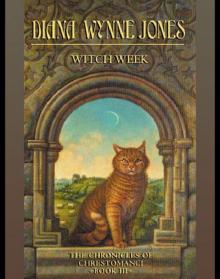 Witch Week
Witch Week Year of the Griffin
Year of the Griffin Wild Robert
Wild Robert Earwig and the Witch
Earwig and the Witch Witch's Business
Witch's Business Dogsbody
Dogsbody Caribbean Cruising
Caribbean Cruising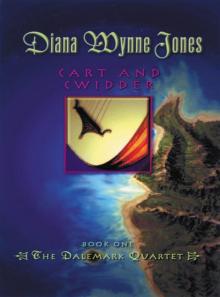 Cart and Cwidder
Cart and Cwidder Conrad's Fate
Conrad's Fate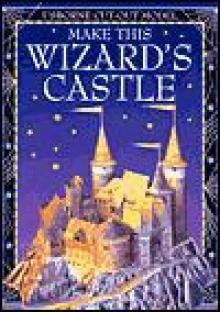 Howl's Moving Castle
Howl's Moving Castle The Spellcoats
The Spellcoats The Pinhoe Egg
The Pinhoe Egg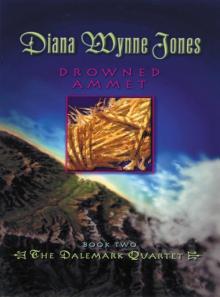 Drowned Ammet
Drowned Ammet The Ogre Downstairs
The Ogre Downstairs Dark Lord of Derkholm
Dark Lord of Derkholm Castle in the Air
Castle in the Air The Magicians of Caprona
The Magicians of Caprona A Tale of Time City
A Tale of Time City The Lives of Christopher Chant
The Lives of Christopher Chant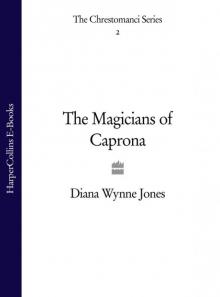 The Magicians of Caprona (UK)
The Magicians of Caprona (UK)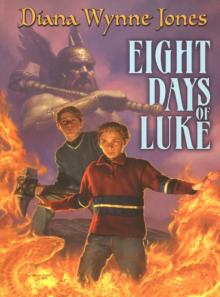 Eight Days of Luke
Eight Days of Luke Conrad's Fate (UK)
Conrad's Fate (UK)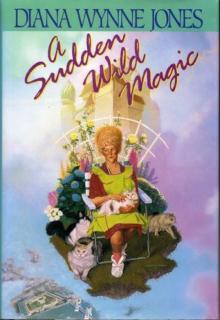 A Sudden Wild Magic
A Sudden Wild Magic Mixed Magics (UK)
Mixed Magics (UK) House of Many Ways
House of Many Ways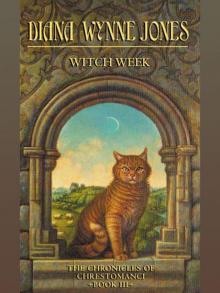 Witch Week (UK)
Witch Week (UK) The Homeward Bounders
The Homeward Bounders The Merlin Conspiracy
The Merlin Conspiracy The Pinhoe Egg (UK)
The Pinhoe Egg (UK) The Time of the Ghost
The Time of the Ghost Hexwood
Hexwood Enchanted Glass
Enchanted Glass The Crown of Dalemark (UK)
The Crown of Dalemark (UK)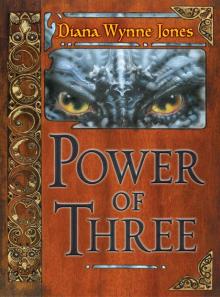 Power of Three
Power of Three Charmed Life (UK)
Charmed Life (UK) Black Maria
Black Maria The Islands of Chaldea
The Islands of Chaldea Cart and Cwidder (UK)
Cart and Cwidder (UK) Drowned Ammet (UK)
Drowned Ammet (UK) Charmed Life
Charmed Life The Spellcoats (UK)
The Spellcoats (UK) Believing Is Seeing
Believing Is Seeing Samantha's Diary
Samantha's Diary Aunt Maria
Aunt Maria Vile Visitors
Vile Visitors Stopping for a Spell
Stopping for a Spell Freaky Families
Freaky Families Unexpected Magic
Unexpected Magic Reflections
Reflections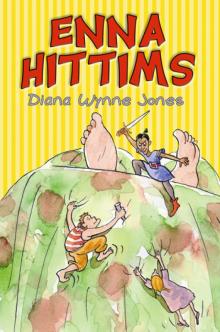 Enna Hittms
Enna Hittms Mixed Magics: Four Tales of Chrestomanci
Mixed Magics: Four Tales of Chrestomanci